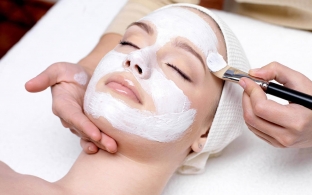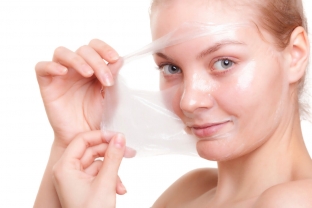Did you know that the strange word "exfoliation", which comes from the Latin word exfoliare and literally translates as "to deleave", is the sibling of the familiar word "peeling". Peeling is one of the most popular and demanded cosmetic procedures. By exfoliating dead cells of the stratum corneum, peeling reveals young, fresh skin, which is devoid of various superficial damage and imperfections. In today's article, estet-portal.com talks about acid peels, each of which has its own specific effects on the skin.
Peculiarities of chemical peeling with acids
Acid peeling or chemical peeling – it is an effective method of cleansing the skin by accelerating its natural exfoliation with the help of special chemical formulations. Chemical peeling, depending on the depth of exposure to the skin, can be superficial, medium and deep.
At present, a huge amount of acids are used for chemical peels, each of which is capable of affecting the skin at one level or another.
Knowledge about the properties, capabilities and characteristics of each of these acids is necessary for a cosmetologist to correctly and effectively perform peeling in each individual case.
Acid peeling: basic properties of acids
In order to properly perform an acid peel that suits the patient's skin type, it is necessary to know about the characteristics of acids. If the active ingredient for peeling is chosen incorrectly, at best, peeling may simply be ineffective, and at worst – even harm the patient's skin. The following acids are currently used for chemical peels:
1. Glycolic acid
Frucic acid, which is most often used in cosmetology. It is active, penetrates deep into the skin. Works in several directions: stimulates the work of fibroblasts, increasing the production of collagen and elastin, smoothes the skin, reduces wrinkles, deeply cleanses the skin, effectively acts against comedones and post-acne, reduces stretch marks and scars. However, glycolic acid is not suitable for sensitive skin as it causes photosensitivity.
You may be interested in: Medium and deep peels - mechanism of action
2. Salicylic acid
This type of peeling with acids is ideal for owners of oily, problematic skin. This acid is active, but not able to penetrate deep into the skin. Well loosens the stratum corneum and dissolves sebum from the inside, cleanses pores, regulates the activity of the sebaceous glands, fights acne and post-acne, but also causes sensitivity to the sun.
3. Mandelic acid
The only acid that can be used in the inflammatory process. It acts gently, slowly and does not penetrate deeply into the skin, is effective in treating acne and post-acne, regulates the activity of the sebaceous glands, stimulates the synthesis of elastin and collagen, has a lifting effect, moisturizes and tones the skin. Mandelic acid does not cause photosensitivity.
Read more: Exfoliation without problems: almond peeling
4. Lactic acid
Lactic acid is related to the human body, as it is part of the skin's natural moisturizing factor. It easily penetrates deep into the skin, but it acts very gently. Lactic acid maximally moisturizes and whitens the skin, stimulates the work of fibroblasts, increases the synthesis of ceramides, reduces the depth of wrinkles and prevents inflammation. Peeling with acids of this kind does not cause photosensitivity, but should be used with caution in rosacea.
5. Malic Acid
Mild and versatile acid that cleanses and moisturizes the skin well, relieves inflammation, restores the hydrolipidic mantle, evens out complexion and even strengthens capillaries. Does not cause photosensitivity, ideal for sagging, tired and aging skin.

6. Citric acid
Affects gently, does not penetrate into the deeper layers of the skin, whitens well, normalizes the pH level. Citric acid has disinfectant properties, it improves skin elasticity and does not cause photosensitivity.
7. Tartaric acid
It is an excellent biostimulant and antioxidant, fights free radicals. Peeling with acids from grapes and winemaking waste can be used on any part of the body, it deeply cleanses the skin, whitens and moisturizes it, stimulates fibroblasts, tones and improves microcirculation, and does not cause hypersensitivity to ultraviolet rays.
Very important: Cosmetics with acids are a source of youth and beauty
8. Pyruvic acid
When applied to the skin, it turns into lactic acid, normalizes the functioning of the sebaceous glands, effectively fights inflammation, disinfects and dissolves stagnant spots. Pyruvic acid stimulates the synthesis of collagen and elastin more actively than others, regenerates, moisturizes and whitens the skin, but can cause photosensitivity.
9. Ferulic acid
Despite its mild effect, it is one of the strongest antioxidants, protects the skin from ultraviolet rays, restores sun-damaged skin. Ferulic acid slows down the aging process, stimulates fibroblasts, strengthens blood vessels and brightens the skin, does not cause photosensitivity.

10. Phytic Acid
A very mild acid that slowly and not deeply penetrates the skin, stimulates metabolic processes, regeneration and fibroblasts. It has a good lifting effect, brightens the skin, smoothes fine wrinkles, scars and stretch marks and does not cause sensitivity to the sun.
It is important to carry out peeling with acids, taking into account the individual characteristics of the skin and the needs of the patient, and, in accordance with this, selecting active chemicals for peeling.
With a competent approach and proper procedure, the patient will be able to get pronounced effects from chemical peeling with acids.
But not only the face is important, but also the figure. Watch, download, do!









Add a comment